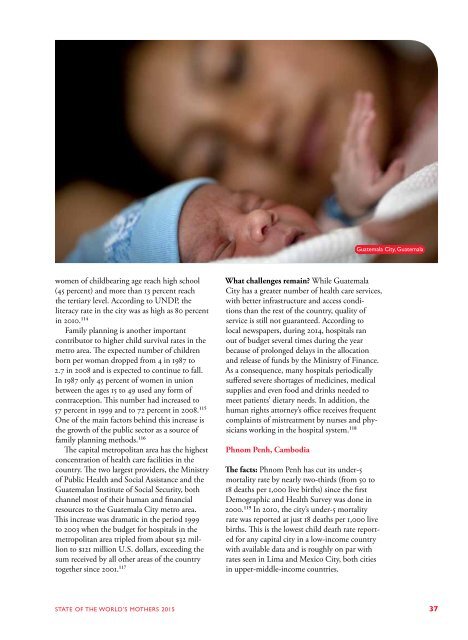sowm_2015__int__africa_full_report_low_res
sowm_2015__int__africa_full_report_low_res
sowm_2015__int__africa_full_report_low_res
You also want an ePaper? Increase the reach of your titles
YUMPU automatically turns print PDFs into web optimized ePapers that Google loves.
Guatemala City, Guatemala<br />
women of childbearing age reach high school<br />
(45 percent) and more than 13 percent reach<br />
the tertiary level. According to UNDP, the<br />
literacy rate in the city was as high as 80 percent<br />
in 2010. 114<br />
Family planning is another important<br />
contributor to higher child survival rates in the<br />
metro area. The expected number of children<br />
born per woman dropped from 4 in 1987 to<br />
2.7 in 2008 and is expected to continue to fall.<br />
In 1987 only 45 percent of women in union<br />
between the ages 15 to 49 used any form of<br />
contraception. This number had increased to<br />
57 percent in 1999 and to 72 percent in 2008. 115<br />
One of the main factors behind this increase is<br />
the growth of the public sector as a source of<br />
family planning methods. 116<br />
The capital metropolitan area has the highest<br />
concentration of health care facilities in the<br />
country. The two largest providers, the Ministry<br />
of Public Health and Social Assistance and the<br />
Guatemalan Institute of Social Security, both<br />
channel most of their human and financial<br />
<strong>res</strong>ources to the Guatemala City metro area.<br />
This increase was dramatic in the period 1999<br />
to 2003 when the budget for hospitals in the<br />
metropolitan area tripled from about $32 million<br />
to $121 million U.S. dollars, exceeding the<br />
sum received by all other areas of the country<br />
together since 2001. 117<br />
What challenges remain? While Guatemala<br />
City has a greater number of health care services,<br />
with better infrastructure and access conditions<br />
than the <strong>res</strong>t of the country, quality of<br />
service is still not guaranteed. According to<br />
local newspapers, during 2014, hospitals ran<br />
out of budget several times during the year<br />
because of prolonged delays in the allocation<br />
and release of funds by the Ministry of Finance.<br />
As a consequence, many hospitals periodically<br />
suffered severe shortages of medicines, medical<br />
supplies and even food and drinks needed to<br />
meet patients’ dietary needs. In addition, the<br />
human rights attorney’s office receives frequent<br />
compla<strong>int</strong>s of mistreatment by nurses and physicians<br />
working in the hospital system. 118<br />
Phnom Penh, Cambodia<br />
The facts: Phnom Penh has cut its under-5<br />
mortality rate by nearly two-thirds (from 50 to<br />
18 deaths per 1,000 live births) since the first<br />
Demographic and Health Survey was done in<br />
2000. 119 In 2010, the city’s under-5 mortality<br />
rate was <strong>report</strong>ed at just 18 deaths per 1,000 live<br />
births. This is the <strong>low</strong>est child death rate <strong>report</strong>ed<br />
for any capital city in a <strong>low</strong>-income country<br />
with available data and is roughly on par with<br />
rates seen in Lima and Mexico City, both cities<br />
in upper-middle-income countries.<br />
STATE OF THE WORLD’S MOTHERS <strong>2015</strong> 37




